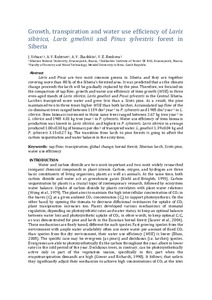Growth, transpiration and water use efficiency of Larix sibirica, Larix gmelinii and Pinus sylvestris forest in Siberia
Скачать файл:
URI (для ссылок/цитирований):
https://www.actahort.org/books/1222/1222_17.htmhttps://elib.sfu-kras.ru/handle/2311/128526
Автор:
Urban, J.
Rubtsov, A. V.
Shashkin, A. V.
Benkova, V. E.
Коллективный автор:
Институт экологии и географии
Лаборатория Биогеохимии экосистем
Дата:
2018-11Журнал:
Acta HorticulturaeКвартиль журнала в Scopus:
Q4Квартиль журнала в Web of Science:
без квартиляБиблиографическое описание:
Urban, J. Growth, transpiration and water use efficiency of Larix sibirica, Larix gmelinii and Pinus sylvestris forest in Siberia [Текст] / J. Urban, A. V. Rubtsov, A. V. Shashkin, V. E. Benkova // Acta Horticulturae: Proc. of the X International Workshop on Sap Flow. — 2018. — № 1222. — С. 125-131Текст статьи не публикуется в открытом доступе в соответствии с политикой журнала.
Аннотация:
Larix and Pinus are two of the most common genera in Siberia. They together cover more than 80% of the Siberia’s forested area. In a warming climate, larch may be replaced by pine. Here we compare sap flow, growth and water use efficiency of stem growth (WUE) in three even-aged stands of Larix sibirica, Larix gmelinii, and Pinus sylvestris in Central Siberia in order to better understand possible changes in future water and carbon fluxes. Larch species transpired more water than Scots pine. As a result, pine maintained higher WUE than both larches. Water use efficiency of stem biomass production was lowest in Larix sibirica and highest in P. sylvestris. Larix sibirica produced 1.00±0.30 kg of biomass dm-3 of transpired water, L. gmelinii produced 1.39±0.04 kg dm-3 and P. sylvestris produced 3.15±0.27 kg dm-3. Results suggest the transition from larch to pine forests will likely affect tree-level carbon and water balance either by decreased tree transpiration or increased carbon sequestration. Increased water use efficiency may also increase tree resilience to a warm and dry climate.

